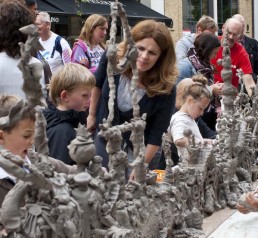Ancient sea in Eridania, Mars, revealed by clay
Clay Mineralogy Researcher, Javier Cuadros, has kindly contributed an update for Clayground readers about recent developments in research into clay on Mars.
The Noachian period on Mars, more than 3,700 million years ago, was the time when water was most abundant in the red planet. How abundant, we do not know exactly. Precisely because water was present on the Martian surface and subsurface, this is the period when most clay mineral deposits were formed on Mars. Clays can tell us much about the environments where they formed. If we know the specific clay minerals (for example, kaolinite, talc, montmorillonite, etc.) in any deposit and we can ascertain that they formed there, rather than being transported from somewhere else, then we can use this information with other geological data to infer what that place was like at the time of clay formation. This can be done on Earth and also on Mars.
There has been geological evidence that a large sea (3 times the size of the Caspian Sea on Earth) existed 3,800 million years ago in the Eriadania basin on Mars. Now, a team including me has investigated deposits of clay and other minerals in the basin where the sea was located, using remote sensing data from satellites. They found that the deepest parts of the basin have a surface criss-crossed by abundant lines suggesting volcanic activity similar to ocean ridges found on Earth. The clays there are also iron- and magnesium-rich, just like those occurring in ocean ridges. A few years ago my colleagues and I studied these types of clays and reported on them to Clayground Collective. Our precise motivation was to investigate clays on Earth with the same mineral and chemical composition as those on Mars, in order to gain information about possible environments where the Martian clays could have formed.
On the edges of the Eridania basin where the sea-coast was, as indicated by numerous channels generated by water that come to end in these areas, there are deposits of salts. This is precisely what can be expected in a sea with very high salt concentration, as no doubt characterised the Eridanian sea, and in which there are sea level changes. Playas and lagoons would have preserved water ponds which created the salt deposits after evaporation.
This story tells us that environmental conditions can be reproduced in different planets with the consequence that the same processes take place, generating the same rocks. When my colleagues and I started studying iron- and magnesium-rich clays from submarine ridges years ago we did not imply that we would find environments on Mars identical to those from which our clays came. This is because relatively different environments can also produce similar rocks. However, our work has gone beyond our expectations and has produced evidence that some of the iron- and magnesium- rich clays on Mars come from a submarine environment.

Image of the Eridania basin on Mars showing in blue the areas that were covered with water. Lighter to darker blue indicates shallower to deeper water. Also in the picture are numerous water channels, many of which end at the coastline. The coloured squares show the position where clays and salts are found.
Image simplified from Michalski J.R., Noe Dobrea E.Z., Niles P.B., Cuadros J. (2017) Ancient hydrothermal seafloor deposits in Eridania basin on Mars. Nature Communications 8, 15978. DOI: http://www.nature.com/articles/ncomms15978
-
Pandemic clay action!
18th Aug 21
-
The Volcano and the Microbes: interaction between geology and biology
4th Jun 21
-
Perseverance: a new NASA rover continues to follow Martian clay
2nd Aug 20
-
Research into clay provides clues as to how much water there was on Mars
18th Sep 19
-
22 Hands: British Ceramics Biennial Commission
12th Aug 19
-
Clayground Summer Events
24th Jun 19
-
Colourful Clays on Mars
20th Feb 19
Thames foreshore fragments and visual references
4th Dec 12
How is clay formed? Is it inorganic or organic?
10th Sep 12
CLAY FROM AROUND THE WORLD
3rd Aug 11
Clay Cargo 2014 Collection: the Thames Foreshore
15th Dec 14
Clues to life on Mars likely to be found in clays, Javier Cuadros
5th Aug 16
Clay Cargo 2013-2015
15th Jun 15
Sessions on the Clay Cargo boat, hosted by Fordham Gallery
9th Mar 15
Civic Spaces, Exhibitions
Museums and Galleries, Regeneration
Maker spaces, Rural Sites
Archaeology
Youth and Adult Community Groups, Professionals
Art Groups, Families, Students
Collaborations, Archaeology Sheets
Commissions, Thinking Hands? Research
Knowledge Exchange






